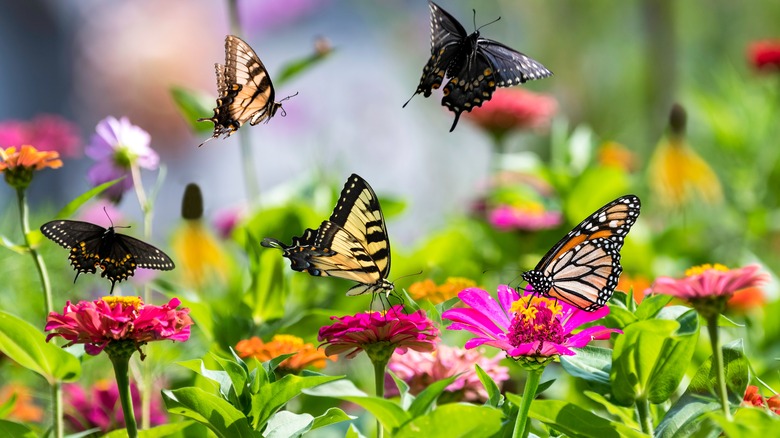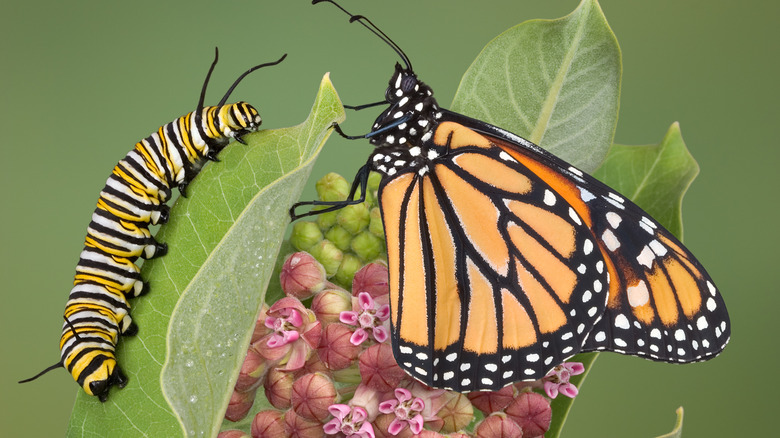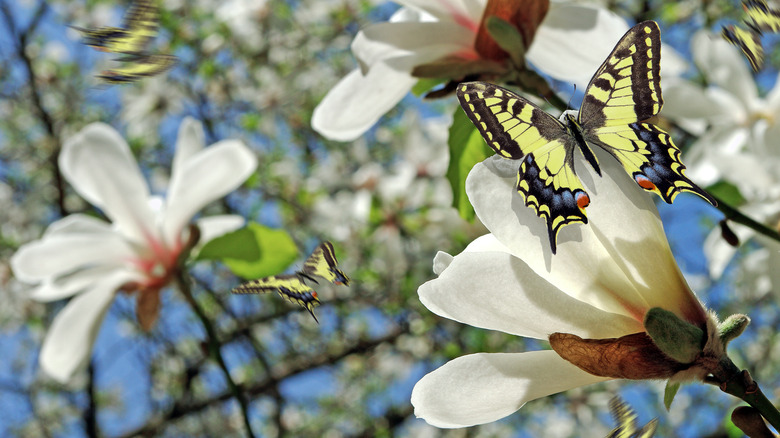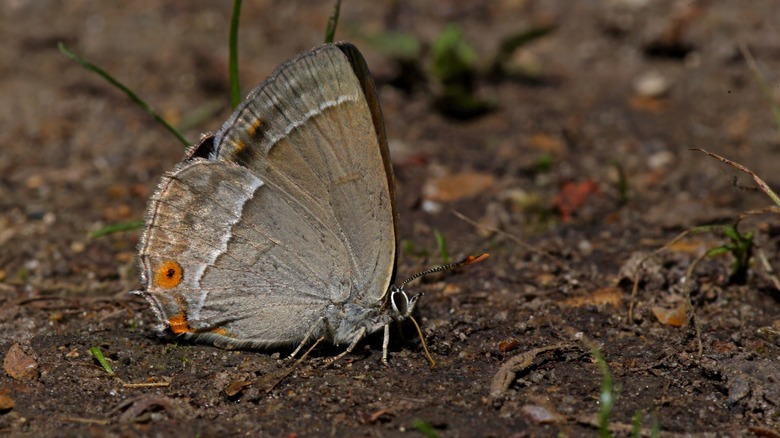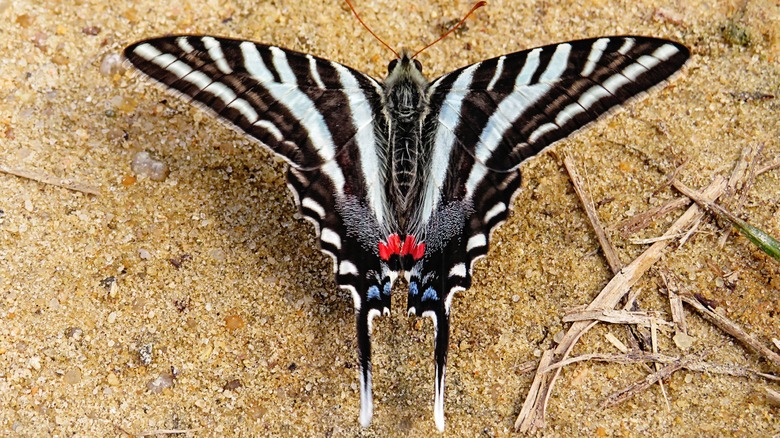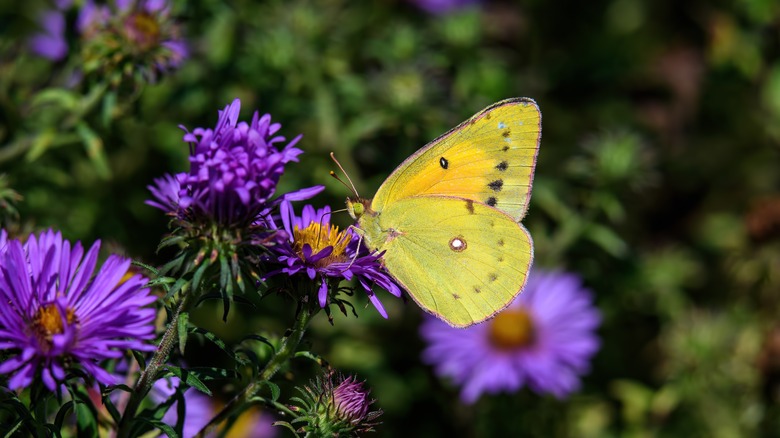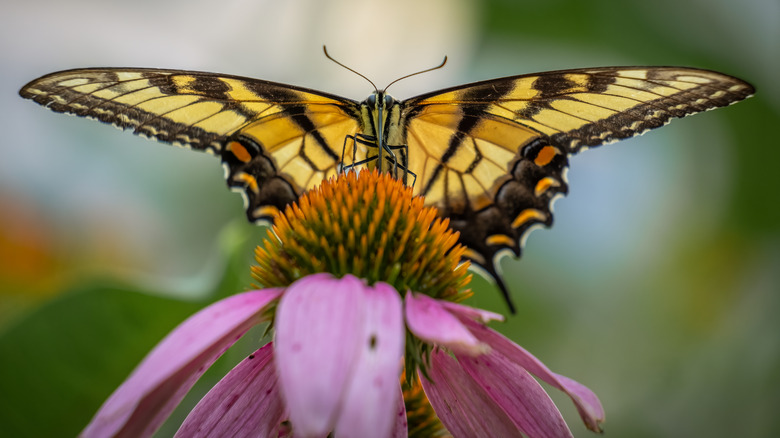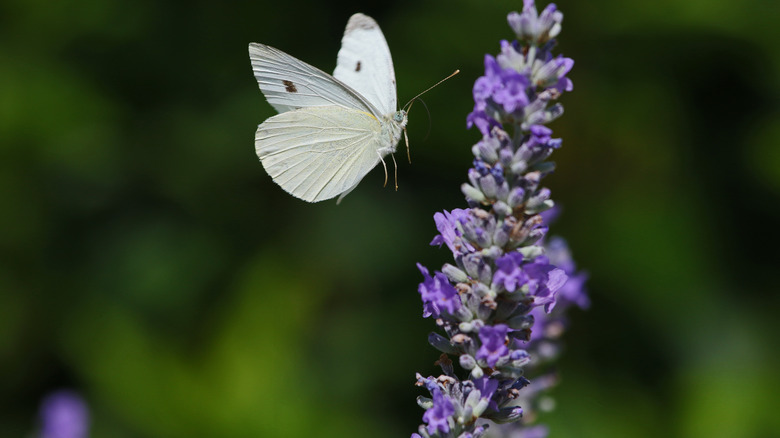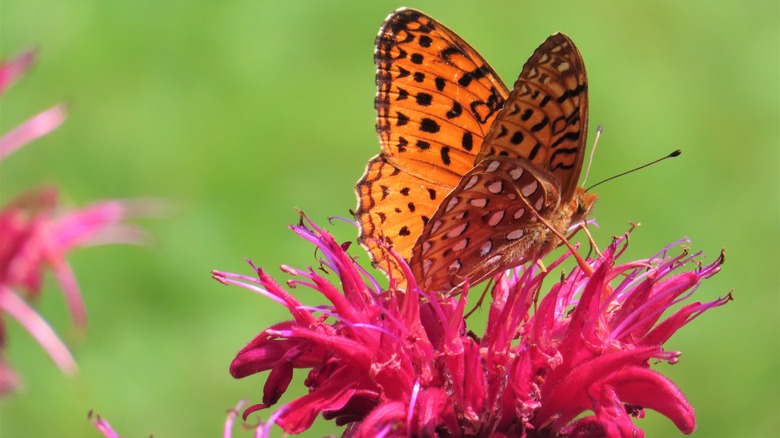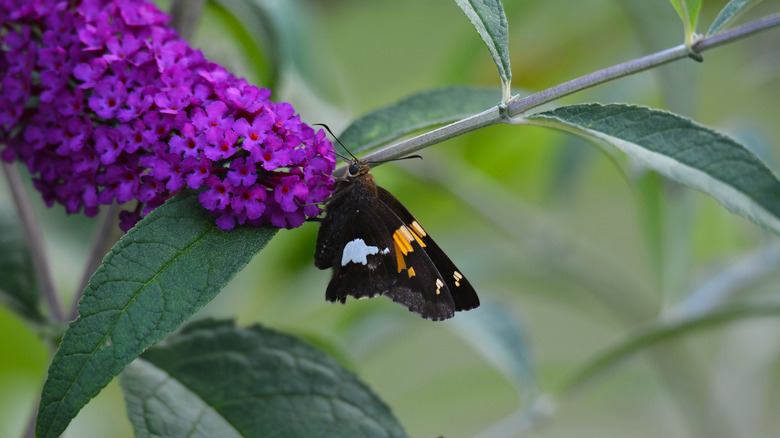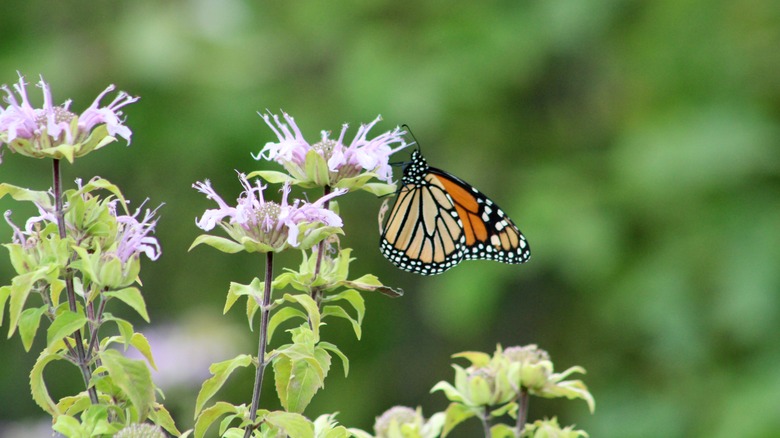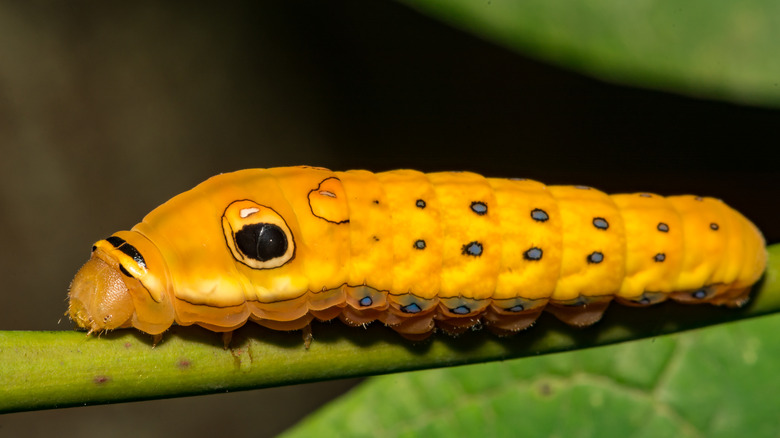Plants That Will Fill Your Garden With A Variety Of Butterflies
What is more beautiful than butterflies flooding your space when the weather warms up and your flowers open? For many gardeners, this is a massive bonus for working so hard on their yards, and dozens of plants make excellent food sources to keep butterflies coming back. However, some plants work better than others, so you have to understand that attracting butterflies is more work than just cultivating blooms. Instead, you must choose plants (and trees) that meet the butterflies' needs as they move through their life cycles. You want pretty plants that feed the butterflies from caterpillars to adults, give them shelter, and set up ideal breeding conditions.
By focusing on these plants, you can create a butterfly haven in your yard or garden that brings them in from spring until late summer. Having new food sources available when others die off is critical for attracting migratory species like monarchs, and it helps keep these colorful visitors around when your garden starts to go dormant during the fall and winter months. While providing a steady stream of butterfly food can take some trial and error, having a solid starting point and understanding how to keep the right plants healthy will transform your space into a butterfly haven.
Parsnip-flower buckwheat feeds Acmon blue butterflies
Parsnip-flower buckwheat is a robust perennial plant, making it a great addition to your garden. Pick a sunny area for planting, and amend the ground so it drains well. Parsnip-flower buckwheat does best in sandy or rocky soil. Sow the seeds right into the ground early in the spring, leaving roughly 9-18 inches of space so the plants can spread. Water the seedlings and keep the soil moist until they establish, after which you can cut back on watering to cater to this drought-tolerant species. Parsnip-flower buckwheat is a relatively low-maintenance plant, so you won't have to dedicate much energy to keeping it healthy after the seeds germinate.
Acmon blue butterflies love this plant and tend to gravitate toward smaller-statured flowers to feed on and lay their eggs. They hang around parsnip-flower buckwheat because each plant produces multiple tiny flowers in its umbrels, which are an excellent food source during flight periods. The flat-topped flower clusters make it very easy for butterflies to feast on them and provide cream and rose colors for your garden. Parsnip-flower buckwheat blooms from early May until late July or longer, depending on the altitude. In some spots, it can bloom until October, providing a steady late-season food source to support butterfly species like the Acmon blue. Planting parsnip-flower buckwheat allows you to create a lively ecosystem in your yard where you can watch this butterfly's life cycle.
Milkweeds attract monarch butterflies
One of the biggest benefits of growing a milkweed plant is arguably the monarch butterflies that flock to it. To start, pick a cultivar that thrives in your climate. Common milkweed does very well in zones 3–10 if you plant it in well-drained soil and full sun. Some species, like butterflyweed, can also thrive in poor soil. Plant your seeds in the fall to cold stratify during the winter and pop out in the spring. If you want to plant them in springtime, cold stratify the seeds in the refrigerator between sheets of damp paper towel in a ziplock bag for roughly a month before you plant them. Put the seeds ¼ inch into the ground, cover them, and routinely water until the plants are established. They'll grow in size in the first summer, but it may take two or three years before you see flowers, so be patient.
Milkweed is a lifeline for monarch butterflies because it's where their larvae hatch and grow and provides everything they need to thrive. Monarch caterpillars are unique in that they only consume milkweed, making it an absolutely imperative part of their lifecycle. A unique chemical compound in milkweed sap makes monarch larvae less desirable to predators. This plant's pretty flowers are also an abundant nectar source that attracts adult monarchs to feed. By planting milkweed, you'll be giving local monarch butterflies support throughout their lives, helping to increase the population and provide them with the food they need to migrate.
Sweetbay magnolia feeds the eastern tiger swallowtail
Sweetbay magnolia brings butterflies and other benefits to your yard and is a pretty addition to any garden, with creamy white flowers and green, glossy foliage. This tree does best in zones 5–10, and it loves moist, acidic soils. Most magnolias prefer well-draining ground, but the sweetbay species can tolerate slightly wetter soil. Pick a spot with full sun or semi-shade, and plant it in the early spring. The planting hole should be the same depth as the tree's root bundle and two times the diameter, and you want to backfill the soil and soak it to help the roots settle. Applying mulch and leaving a few inches around the base will deter weeds from growing and competing for nutrients and help lock moisture into the soil.
The big, fragrant flowers of the sweetbay magnolia draw eastern tiger swallowtails in and bloom from late spring until into the beginning of summer. The blooms are a valuable source of nectar for the eastern tiger swallowtail during the active seasons. The shiny leaves also give butterflies shelter, along with other pollinators. The larvae eat the foliage of the sweetbay magnolia, making it the perfect host plant for the adults to lay their eggs on. Include this small tree in your garden, and you will support the eastern tiger swallowtail's life cycle and grow an ornamental beauty.
Mistletoe draws the great purple hairstreak in
When you think of mistletoe, you probably picture the holidays, thanks to its bright red berries and deep green foliage. Most people are familiar with the festive appearance of the plant, but many don't know that this is a semi-parasitic species that needs a host tree to grow on, like hawthorn or apple. To propagate mistletoe, harvest the fresh berries from November to March, when they get soft. Carefully remove the berries, squeeze them to a pulp, and press them into your host tree's branches on the underside. Since they attach to the bark, you don't have to worry about soil. Ensure they get as much contact as possible so the seeds germinate and the roots get into the bark. Once placed, it'll take a few years before you see flowers. You won't need to fertilize or water the seeds because they pull moisture and nutrients from the host tree.
The great purple hairstreak butterfly loves mistletoe and needs it to survive. The foliage and tiny, hidden flowers mistletoe plants produce are the key to this relationship, and they bloom early during late spring to early summer. The nectar and leaves attract and feed the great purple hairstreak, and they lay their eggs on the plant. After hatching, the larvae feed exclusively on mistletoe foliage, and the dense growth provides excellent shelter. Mistletoe's unique growth habit also makes it a point of interest in the garden, and you'll get uniquely colored butterflies flocking to it.
Zebra swallowtails eat the pawpaw plant
Pawpaw is a deciduous tree that comes from the eastern part of the United States, producing large fruit and droopy, big leaves. To grow a pawpaw tree in your garden, pick a sunny, wind-protected area, but take steps to shade the seedlings, as younger trees are sensitive to direct light. Plant during the springtime in well-draining, rich soil with a pH of 5.5 to 7. To cross-pollinate and produce fruit, you'll need at least two trees. Plant them roughly 8–10 feet apart so the canopies can spread, and water regularly during the first two years until they are established. Once they've taken hold, pawpaw trees are low-maintenance plants with few pest issues.
In addition, the pawpaw fruit tree will attract zebra butterflies to your space, like zebra swallowtails. They rely on the leafy parts of these plants for food for their larvae, and females use the trees to deposit one egg on the underside of each leaf. This is the only foliage that the caterpillars will consume, and it has a chemical compound that causes the larvae to taste terrible to predators. Also, the big leaves give shelter and protect the caterpillars as they grow. Having a few pawpaw trees in your yard or garden will help increase the zebra swallowtails' population, allowing you to watch them develop and grow, and you might even be able to harvest some fruit.
Sulphurs love to feed on asters
When you learn how to grow and take care of asters, you'll be setting your space up as a butterfly haven. Asters flower from late summer into fall and thrive in zones 3-8 in full sun or partial shade. For bountiful blooms, you'll want well-drained, loamy soil with compost to enrich it. Plant the seedlings or seeds in springtime after the frost risks are over. Water your asters at least once per week to keep the soil moist, especially in dry conditions. Mulching around them helps maintain moisture in the soil, and splitting asters approximately every two to three years during spring keeps the mounds healthy. Deadheading fading flowers encourages plants to produce fresh blooms.
Besides putting on a colorful show, the flowers draw sulphur butterflies to the yard. Asters also offer nectar during the late summer and fall months, ensuring these brilliant butterflies have food when a lot of summer-blooming flowers naturally fade for the year. Also, the vibrant colors, ranging from deep blue, purple, and hot pink, are a welcome sight in the garden. They'll give you plenty of late-season color and support the butterflies' nutritional needs.
Coneflowers attract eastern tiger swallowtails
Coneflowers are perennials with broad, vibrant blossoms. They prefer well-lit environments to thrive, so you'll need to put them in a position where they receive at least 6–8 hours of sunlight. Plants like well-draining, loamy soil, but once they've established their deep root systems, these pretty perennials can handle drought. Sow the seeds after the last frost in the spring, spreading them at least a foot apart to allow room for the plants to fill out. Water them to keep the soil moist and encourage deep roots for the first year, and cut back after unless there's a drought. As the flowers fade, consider deadheading to encourage the plants to create new blooms throughout the summer and into early fall.
Eastern tiger swallowtails love coneflowers because of the sweet, quality nectar. The flat-topped blooms make them an excellent place for the butterflies to land and feed. The high nectar production in mid- to late-summer ensures the butterflies have a continuous food source, and several species use it for nectar. Having coneflowers can increase the number of colorful butterflies and pollinators you have in your garden, and the eastern tiger swallowtail also plays a role as a pollinator for other plants.
Grow lavender to draw cabbage white butterflies
Thriving in zones 5-9, the best spot in your garden to plant lavender is one that gets full sun with sandy, well-drained soil. You'll want to plant new bushes in either spring or fall (depending on your region) so they can set roots before colder weather comes along, or get established before any intense summer heat. To start, dig a hole twice as large as the root ball. Space your plants 1-3 feet apart to provide room to grow, and give them generous yet infrequent waterings to encourage deep roots. Lavender is drought-resistant when established so avoid watering too much to stave off root rot. Mulching with rocks or gravel will help keep the soil on the drier side and your plant happy. Prune in the early spring to encourage fresh, bushy growth.
Cabbage white butterflies like lavender because it has vibrant blooms with a lot of nectar. The rich ambrosia attracts the butterflies and encourages them to feed. Some lavender species will bloom from spring until the end of summer, and this helps ensure that the butterflies in your garden get a constant food supply right into early fall. Also, since lavender can grow in clumps up to 24 inches wide, several butterflies can feed simultaneously. Adding lavender to your landscape gives you a wonderfully fragrant ornamental plant that draws in pollinators.
Bee balm feeds great spangled fritillary butterflies
Bee balm produces pretty crown-like flowers that will attract a host of pollinators to your butterfly garden. It grows best in zones 3–9 and loves full sun to partial shade. The soil should be rich and drain well to support healthy growth. Plant bee balm in the spring or early fall to ensure it has time to develop roots before extreme weather conditions, and space plants 18–24 inches apart to let air circulate and ward off powdery mildew. Water regularly to promote healthy growth, and mulch around the plants to help suppress weeds and retain moisture. This fast-growing species can spread, so split your plants every 2-3 years to keep them healthy and thriving. If you deadhead fading flowers, they'll produce more through the summer.
Great spangled fritillary butterflies love bee balm because of the orange scent and the rich nectar content. The unique flower shape makes an excellent platform for the butterflies to land on, allowing for easy nectar access. The vibrant red and pink coloring will give welcome pops of color to your garden, and the long blooming period (from the middle of summer to early fall) provides butterfly food when other flowers are dying. This plant is excellent for supporting the local great spangled fritillary butterfly population and adding diversity to your space.
Plant phlox to bring skippers to your yard
Phlox is a charming plant that produces a lot of flowers in pretty colors to brighten up your yard. To grow it, pick a spot in the garden that gets mostly sun or semi-shade. Full sun will give you the most flowers. Phlox plants love well-drained, relatively rich ground, so be sure to add compost to their soil. Plant in early spring or fall for optimal root development, and space phlox 18 inches apart to ensure good air circulation and prevent fungal diseases. Water regularly to keep the soil moist (roughly an inch of water weekly), and consider adding mulch around the base of plants. Deadhead as the flowers fade to encourage new blooms.
Phlox is attractive to skippers, which are small, fast butterflies that love the plant's nectar. The star-shaped flower clusters make it easy for butterflies to feed on several flowers in a short period. The flowers are also very colorful, ranging from deep purple and vibrant pink to white. The extended blooming period is another bonus, as it gives butterflies food from spring to late summer, and skippers need it as they can produce multiple generations in a season. Adding phlox to your garden will provide a vibrant display and a habitat for these zippy butterflies to thrive.
Joe Pye weed attracts monarchs and swallowtails
Joe Pye weed is a pretty perennial that adds drama and height to your garden. You'll want to pick a space with full sun to part shade, but be aware that too much shade can weaken the plant. It likes fertile, moist soil; adding compost will boost the nutrient content and improve water retention. This plant does well in wet areas, like alongside water features or in rain gardens. Plant it in the early springtime and water it deeply once or twice a week when the top few inches of soil feel dry. While it's generally a low-maintenance plant, adding mulch will help keep the ground moist to create the damp conditions that Joe Pye weed loves. It can get up to 7 feet tall, usually doesn't require staking to stay upright, and if you prune it back in late winter or early spring (leaving 4–8 inches of plant), this will promote flowers and keep it looking neat.
Joe Pye weed attracts swallowtail and monarch butterflies, thanks to the big, dusky pink flowers that bloom from mid-summer to early fall. They offer a rich source of nectar for various species of butterflies and other pollinators. To accommodate its height, plant Joe Pye weed along the edges of your garden or in the back so it doesn't block smaller species from receiving adequate sunlight to produce flowers and thrive.
Grow sassafras to attract the spicebush swallowtail
One of the best native plants to grow if you live in New England and want to attract swallowtail butterflies is sassafras. It has aromatic properties and mitten-shaped leaves that give this perennial an eye-catching look. Sassafras thrives in full sun or partial shade. It'll adapt nicely to most light soil types but prefers to be in a sandy, well-drained medium with a mildly acidic to neutral pH level. Plant it in the early springtime in a hole that is three times as wide as the root ball but slightly shallower. Once the plant is centered, backfill the hole with soil, gently tamping it down. In the absence of rainfall, Sassafras needs weekly watering during the first few years as it grows, after which it can withstand drought. You won't need to prune much, except to help encourage a strong structure. If you prune, do so in late winter or early spring.
Sassafrass is vital to the spicebush swallowtail butterfly's survival, a species commonly found in the New England region, as well as the Great Lakes region, Texas, Florida, and beyond. The tree's broad leaves are an excellent food source for the larvae, and females lay one or two eggs per leaf. The caterpillars make nests out of the leaves to hide in during the day. By planting this tree, you'll get year-round scents and visual appeal — and do your part to help the spicebush swallowtail survive.
